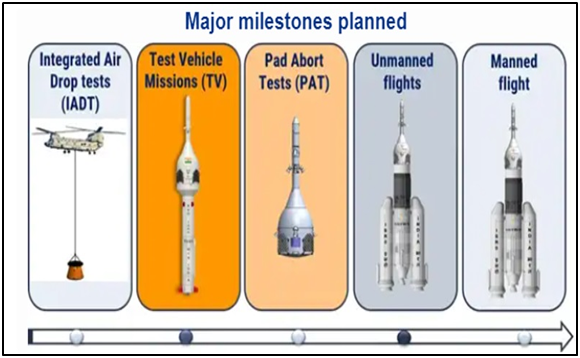Why in news?
- PM Modi has announced the names of the four astronauts, who would fly to low-Earth orbit as part of ISRO’s Gaganyaan.
- The announcement came just days after ISRO said it had successfully tested the human readiness of the cryogenic engine.
- This engine will be used on the LVM3 vehicles for all of the Gaganyaan missions.
What’s in today’s article?
Gaganyaan
- Gaganyaan project envisages demonstration of human spaceflight capability by launching a crew of 3 members to an orbit of 400 km for a 3 days mission and bring them back safely to earth.
- It is part of the Indian Human Spaceflight Programme (IHSP), which was initiated (2007) by the ISRO to develop the technology needed to launch crewed orbital spacecraft into low earth orbit (LEO).
- Launch Vehicle Mark-3 (LVM3/GSLV Mk3) rocket - the well proven and reliable heavy lift launcher of ISRO, is identified as the launch vehicle for Gaganyaan mission.
- India’s heaviest rocket consists of solid stage, liquid stage and cryogenic stage.
- All systems in the LVM3 launch vehicle are re-configured to meet human rating requirements and christened Human Rated LVM3/HLVM3.

News Summary: PM Modi announces 4 astronauts for Gaganyaan
- PM Modi announced the names of the four astronauts, who would fly to low-Earth orbit as part of the ISRO’s Gaganyaan — the first crewed Indian space mission.
- The selected astronauts are:
- Prashanth Balakrishnan Nair, Angad Prathap, Ajit Krishnan, and Shubanshu Shukla.
- They are all either wing commanders or group captains with the Indian Air Force (IAF) and have extensive experience working as test pilots.
Current status of Gaganyaan missions
- The Gaganyaan missions include both manned and unmanned missions.
- The first unmanned Gaganyaan-1 mission, a test flight to check the technology readiness for the final mission, is scheduled to take off by the end of 2024.
- The manned mission, which will fly a three-membered crew into a low earth orbit at an altitude of 400 km for a period of three days, is scheduled later.
- Human rating of the launch vehicle
- ISRO will use its LVM3 rocket for all of the Gaganyaan missions.
- LVM3, earlier called GSLV-MkIII, is the space agency’s most powerful launch vehicle and has flown seven times and never failed.
- For the manned Gaganyaan mission, ISRO has reconfigured all the components of LVM3 to meet human rating requirements.
- Recently, in February 2024, the space agency performed final tests on the rocket’s cryogenic engine, known as CE20, which will power LVM3 during the cryogenic stage of the lift-off.
- The engine successfully passed and was certified for missions that would transport humans into space.
- The ‘Vikas’ engine to be used in the liquid stage and the solid booster, a part of the solid stage, have already qualified for the missions.
- Development of crew module and crew escape system
- ISRO is also developing technology for the proposed human-space flight mission.
- These include:
- the development of life support systems to provide an earth-like environment to the crew in space,
- crew emergency escape provision, and
- evolving crew management aspects for training, recovery, and rehabilitation of crew.
- In October 2023, the space agency successfully conducted the first test of a basic crew module and crew escape system (CES).
- CES is a part of the module that ensures “the crew is taken to a safe distance in case of any emergency either at launch pad or during ascent phase.
- The next month, the space agency began to experiment with a crew module uprighting system.
- This system is used to ensure that the crew module, making a splashdown in the sea after a space mission, stays upright and does not get inverted in the water.
- Training of astronauts
- The four selected astronauts have completed their generic training at Russia’s Yuri Gagarin Cosmonaut Training Centre.
- Their training took place after ISRO-Glavkosmos (a subsidiary of Russian space agency Roscosmos) signed an MOU in June 2019.
- The astronauts are currently undergoing training at ISRO’s astronaut training facility in Bengaluru.
- One of the four astronauts is also expected to be trained by the American space agency NASA.










